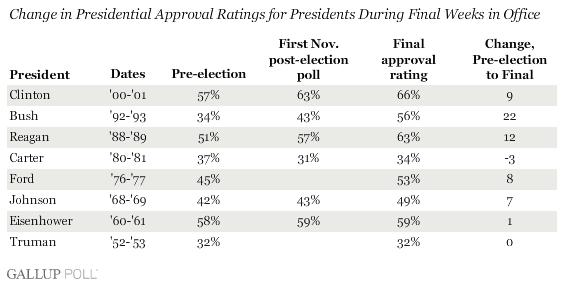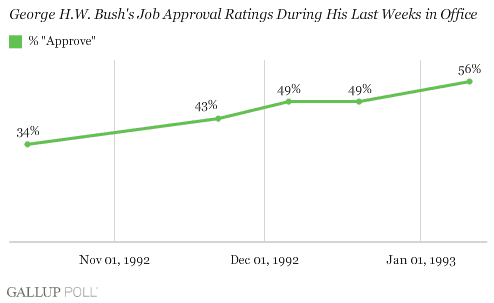PRINCETON, NJ -- It is common for presidents who are about to leave the White House to receive a bump in their job approval ratings between Election Day and Inauguration Day. Of the eight post-World War II presidents who left office after serving two terms, declining to seek an additional term, or being defeated for re-election, six saw increased job approval ratings in their final two-plus months in office.

The last three presidents, and four of the last five who departed at the end of a term, saw significant rises in their ratings. Some of these increases were evident beginning with the first poll conducted after the election.

The largest spike occurred for the elder George Bush, of whom only 34% of Americans approved in October 1992, shortly before Bill Clinton defeated him for re-election. Immediately after the election, Bush's approval rating jumped to 43%, and by the time he left office, his rating had increased further to 56% -- a remarkable increase of 22 percentage points.

Ronald Reagan -- who was succeeded by the elder Bush -- also posted a double-digit approval gain, from 51% just prior to the 1988 election to a final rating of 63%.
Clinton (a 9-point increase), Gerald Ford (8 points), and Lyndon Johnson (7 points) also saw significant increases in their approval ratings between Election Day and Inauguration Day. Clinton's approval rating was already quite strong at 57% at the time of the 2000 election, and after the post-election increase, Clinton left office with a 66% job approval, the highest registered for a retiring president (this preceded a series of controversial last-minute moves for the Clinton administration that caused his popularity to decline after he left office).
Like Clinton, Dwight Eisenhower was also quite popular at the time of the election in which his successor was chosen, but he saw only a slight increase in his approval rating, from 58% to 59%.
Truman and Jimmy Carter are the only two post-World War II presidents whose approval ratings did not improve after their successors were selected. Truman finished his tenure with a low 32% approval rating, the same as before the 1952 election.
Carter is the only president whose approval rating declined after Election Day. He stood at 37% just prior to the 1980 election during which he sought a second term, but saw his job approval rating drop to 31% after Reagan defeated him. It recovered somewhat by the time he left office, but his final 34% approval rating was still below where he stood on Election Day.
A Bush Bounce?
So far, George W. Bush appears to be getting a modest increase in his approval rating. In Gallup's final 2008 pre-election poll, 25% of Americans approved of the job Bush was doing as president. In the immediate days after the election, this increased to 28%, and the most recent polling shows Bush with a 29% job approval rating. Gallup will continue to track Bush's approval rating between now and when Obama takes office.
Implications
Presidents about to leave office generally receive a boost in public support in the final weeks of their presidencies. This may reflect sympathy for presidents who leave in defeat (like the elder Bush or Ford) or perhaps feelings of nostalgia for a favorable era for the country about to end (as for Reagan or Clinton).
It may also reflect the soon-to-be-former president's being viewed in slightly less political terms. Between Election Day and Inauguration Day, the president's successor is the primary focus of political coverage, and the sitting president is likely not pursuing many controversial policies during this time, instead focusing his attention on handing things over to the next president.
As Americans reflect back on George W. Bush's presidency, he will surely leave office as one of the least popular modern presidents, but he may be viewed slightly more positively than when Americans chose Obama to replace him in an election some believe to be a repudiation of Bush and his policies.
Survey Methods
Results are based on telephone interviews with 1,009 national adults, aged 18 and older, conducted Nov. 13-16, 2008. For results based on the total sample of national adults, one can say with 95% confidence that the maximum margin of sampling error is ±3 percentage points.
Interviews are conducted with respondents on land-line telephones (for respondents with a land-line telephone) and cellular phones (for respondents who are cell-phone only).
In addition to sampling error, question wording and practical difficulties in conducting surveys can introduce error or bias into the findings of public opinion polls.
